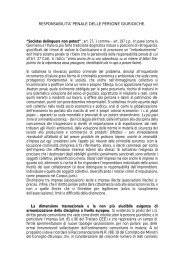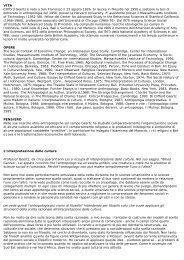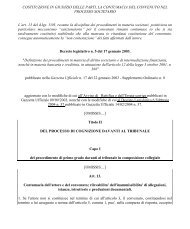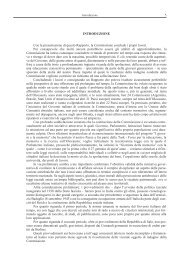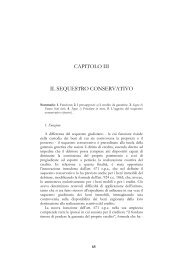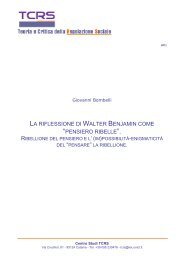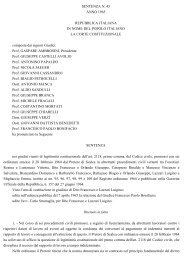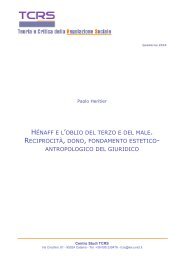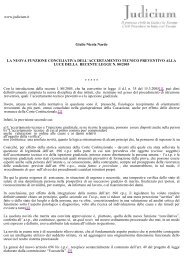Stefano Bartolini
Stefano Bartolini
Stefano Bartolini
Create successful ePaper yourself
Turn your PDF publications into a flip-book with our unique Google optimized e-Paper software.
194<br />
<strong>Stefano</strong> <strong>Bartolini</strong><br />
Riferimenti bibliografici<br />
<strong>Bartolini</strong>, S. (1996), Cosa è «competizione» e come va studiata, in «Rivista Italiana di<br />
Scienza Politica», XXVI, 2, pp. 209-268.<br />
<strong>Bartolini</strong>, S. (1998), Exit Options, Boundary Building, Political Structuring. Sketches of a<br />
Theory of Large-Scale Territorial and Membership ‘Retrenchment/Differentiation’<br />
versus ‘Expansion/Integration’ (with Reference to the European Union), Firenze,<br />
EUI Working Papers, SPS No. 98/1.<br />
<strong>Bartolini</strong>, S. (2000), The Class Cleavage. The Electoral Mobilisation of the European Left<br />
1880-1980, Cambridge, Cambridge University Press.<br />
<strong>Bartolini</strong>, S. (2002), Lo stato nazionale e l’integrazione europea: una agenda di ricerca, in<br />
«Quaderni di Scienza Politica», 9, pp. 397-414.<br />
Chiti, M.P. (1993), Il Trattato dell’Unione Europea e la sua influenza sulla Costituzione<br />
italiana, in «Rivista italiana di diritto pubblico comunitario», 3, pp. 343-366.<br />
Dahl, R.A. (1971), Polyarchy. Participation and Opposition, New Haven-London, Yale<br />
University Press; trad. it. (1980), Poliarchia. Partecipazione e opposizione, Milano,<br />
Angeli.<br />
Easton, D. (1990), The Analysis of Political Structures, London, Routledge.<br />
Eisenstadt, S.N. e B. Giesen (1995), The Construction of Collective Identity, in «Archives<br />
Européennes de Sociologie», XXXVI, 1, pp. 72-102.<br />
Ferrera, M. (2003), European Integration and National Social Sovereignty: Changing Boundaries,<br />
New Structuring?, in «Comparative Political Studies», 36, 6, pp. 611-652.<br />
Flora, P. (1986), Wachstum zu Grenzen. Stabilisierung durch Wandel. Zur historischen<br />
Lage der entwickelten Wohlfahrtsstaaten Westeuropas, in M. Kaase (a cura di),<br />
Analysen zu Theorie und Empirie demokratischer Regierungweise, Opladen, Westdeutscher<br />
Velag, pp. 27-39.<br />
Flora, P. (2000), Externe Grenzbildung und Interne Strukturierung – Europa und seine<br />
Nationen, Eine Rokkanische Forschungperspektive, in «Berliner Journal für Soziologie»,<br />
10, pp. 157-166.<br />
Gierke, O. (1988), Political Theories of the Middle Age, Cambridge, Cambridge University<br />
Press.<br />
Gilbert, M. (2002), Il processo storico dell’Europa integrata, in S. Fabbrini (a cura di),<br />
L’Unione Europea. Le istituzioni e gli attori di un sistema sovranazionale, Roma-<br />
Bari, Laterza, pp. 39-72.<br />
Hintze, O. (1962), Staat und Verfassung, Göttingen, Vandenhoeck & Ruprecht; trad. it<br />
parziale in (1988), Stato e società, Bologna, Zanichelli.<br />
Hintze, O. (1964), Sociologie und Geschichte, Göttingen, Vandenhoeck & Ruprecht; trad.<br />
it. parziale in (1988), Stato e società, Bologna, Zanichelli.<br />
Hirschman, A.O. (1970), Exit, Voice, and Loyalty. Responses to Decline in Firms, Organizations,<br />
and States, Cambridge, Harvard University Press.<br />
Lipgens, W. (1982), A History of European Integration, vol. 1: 1945-1950, Oxford, Clarendon<br />
Press.<br />
Majone, G. (1999), The Regulatory State and its Legitimacy Problems, in «West European<br />
Politics», 22, pp. 1-24.<br />
Milward, A.S. (1992), The European Rescue of the Nation State, London, Routledge.<br />
Moravcsik, A. (1998), The Choice for Europe. Social Purpose and State Power from Messina<br />
to Maastricht, Ithaca, Cornell University Press.<br />
Rokkan, S. (1974), Entries, Voices, Exits: Towards a Possible Generalisation of Hirschman<br />
Model, in «Social Science Information», 13, pp. 39-53.



